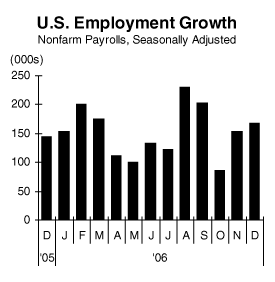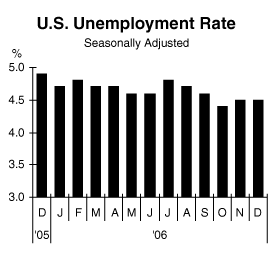|
January 10, 2007
What Recession?
Written by Jeff Thredgold, CSP, President, Thredgold Economic Associates
The American economy continues to demonstrate remarkable resiliency, despite well-documented weakness in the nation’s housing and automotive sectors. That vocal minority of economists who have been tirelessly forecasting imminent recession can (hopefully) move to the backburner.
The U.S. economy added 167,000 net new jobs in December, sharply higher than the 100,000 net gain expected. In addition, estimated job gains in October and November were revised higher by a combined 29,000 jobs.
Calendar year 2006 saw the net addition of 1,840,000 new jobs, a 153,000 average monthly rise. Such growth was in line with the 2.0 million net additional jobs added in 2005 and the 2.1 million jobs added in 2004.
The nation’s unemployment rate remained at 4.5% as expected. Calendar year 2006 saw an average jobless rate of 4.6%, the lowest in six years. The 4.6% average in 2006 compares to the 5.1% average rate in 2005, the 5.5% rate in 2004, and average jobless rates of 5.8% and 6.0% in 2002 and 2003, respectively.
Where the Jobs Were
Employment strength in December was found in the service providing sector, with the addition of 178,000 net new jobs. The impressive gain was led by the addition of 50,000 net new jobs in professional & business services. The sector added 420,000 jobs during the past 12 months. Recent gains were led by new jobs in management and technical consulting services, architecture, engineering, and in computer system design.
The education & health care sector added 43,000 net new jobs in December. Health care added 31,000 of these new jobs and registered a net rise of 324,000 jobs during the year. The leisure & hospitality sector added 31,000 net new jobs in December, with food service and drinking places accounting for 23,000 of the new jobs. Food services added 304,000 net new jobs in 2006.
Various governmental entities added 17,000 net new jobs in December, with the addition of 247,000 jobs during the year. Financial activities added 9,000 jobs in December, with an impressive gain of 153,000 net new jobs during 2006. Gains were primarily driven by a 62,000 net job rise in credit intermediation (which includes commercial banking). The insurance sector added another 46,000 net new jobs.
The nation’s goods production sector continued to struggle in December, with a net loss of 11,000 jobs. Net manufacturing employment declined by 12,000 jobs in December. Total manufacturing employment fell by 72,000 jobs in 2006, even as thousands of high-skill, high-wage manufacturing job openings continued to go begging (see below).
Construction employment fell by 3,000 positions. The broad construction sector added 39,000 jobs in 2006, with gains in heavy construction offsetting more recent weakness in new residential construction. The nation’s natural resources and mining sector enjoyed solid job gains.
Details…Details
The jobless rate of men in December climbed slightly to 4.0%, versus 3.9% in November. The jobless rate for women did just the opposite, dipping to 3.9% in December from 4.0% the prior month. The jobless rate for teenagers was an uncomfortable 15.2% in December, up 0.1% from November.
The jobless rate for Whites was 4.0% in December 2006, down from the 4.2% rate 12 months earlier. The Black or African American jobless rate fell from 9.3% in December 2005 to 8.4% in December 2006. The jobless rate for those of Hispanic or Latino ethnicity dipped to 4.9% during December 2006, down sharply from the 6.0% rate in December 2005. Note: these figures apply only to those in the workforce or actively seeking employment, not the entire population.
Does Education Matter?
Tight labor availability across the nation has helped workers of all levels of educational attainment. No surprise here…however…greater educational achievement led to lower jobless rates. The jobless rate for those with less than a high school education was 6.6% in December 2006, down from the 7.3% rate a year earlier. The jobless rate for high school graduates with no college dipped from 4.6% in December 2005 to 4.3% a year later.
The jobless rate for those with some college or an Associate’s degree fell from 3.9% to 3.4% over the past year, while the jobless rate for those with a Bachelor’s degree or higher dropped from 2.2% in December 2005 to 1.9% in December 2006.
Rising Wages
Tight labor availability has helped push wages higher. This is good news for workers…worrisome news for Federal Reserve officials, who lay awake nights fretting about inflation (that’s their job!).
The average hourly wage rose 0.5% (eight cents) to $17.04. Wages are now up 4.2% over the past 12 months, the largest gain in six years. The 4.2% wage gain was impressive when compared to the 2.0% rise in inflation over the same 12-month period.
Supply & Demand
Employment gains across the nation are primarily driven by the demand for new workers. At times, however, the supply of available labor (especially skilled labor) can influence overall employment gains and economic growth…
…this is one of those times
A shortage of skilled labor in various sectors including manufacturing, health care, construction, trucking, and education are currently limiting U.S. economic growth. Thousands of companies note their ability to expand operations is curtailed by a lack of skilled workers to hire.
The nation’s manufacturing sector is a solid example. The national media is not shy about reporting on jobs moving to China or being cut as certain industries, such as the automotive sector, struggle to be competitive with foreign automakers.
At the same time, however, other manufacturing firms are turning away new orders as their ability to attract and retain workers with critical skills has met with frustration. Skilled workers such as welders, machinists, and electricians are in short supply, with many holding these skills approaching retirement age. Despite solid wages and attractive benefit programs, young people today are not exactly beating down the doors of employers in these “get your hands dirty” industries.
The National Association of Manufacturers surveyed 800 manufacturing firms in 2006. The result?…80% of the firms noted that finding qualified workers was their biggest business problem (USA TODAY).
Bottom Line
The American economy continues to grow at a solid pace, despite weakness in key sectors. Impressive job gains are likely to extend the Federal Reserve’s move to the sidelines enacted at mid-year 2006, with no monetary move expected in coming months.

“Tea”sers
Hillbilly Medical Terms
Benign…what you be after you be eight
Fibula…a small lie
Outpatient…a person who has fainted
Tumor…more than one
|

